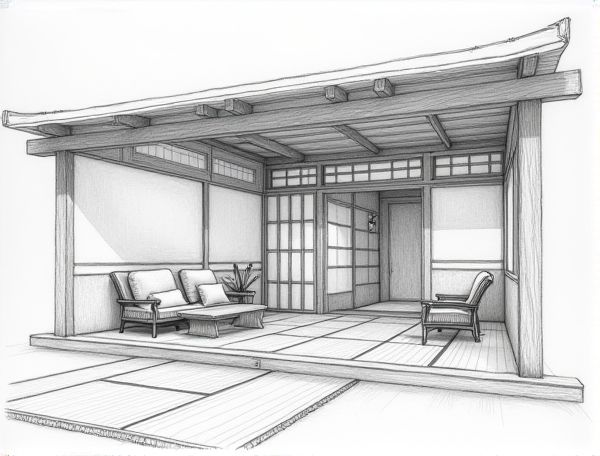
Photo illustration: Traditional Japanese home design with tatami mat flooring
Embrace the serene elegance of traditional Japanese home design through the use of tatami mat flooring, which brings natural textures and a sense of harmony to your living space. Discover how incorporating these mats can enhance comfort, create flexible room layouts, and connect your home with timeless cultural aesthetics by reading more in the article.
Introduction to Traditional Japanese Home Design
Traditional Japanese home design emphasizes natural materials such as wood, paper, and bamboo to create a harmonious and serene living environment. Sliding shoji screens maximize space and light, while tatami mat floors provide comfort and flexibility for various activities. You will appreciate the minimalist aesthetic and seamless connection between indoor and outdoor spaces that define this timeless architectural style.
Historical Significance of Tatami Mats
Tatami mats, originating in Japan during the Heian period (794-1185), hold significant cultural and historical value as traditional flooring materials symbolizing status and aesthetic refinement. These woven rush mats were initially reserved for nobility and Samurai, representing a blend of practicality and elegance in home design. Incorporating tatami into modern interiors not only preserves historical craftsmanship but also enhances spatial harmony and natural comfort.
Key Features of Japanese Interior Layout
Japanese interior layout emphasizes minimalism, natural materials, and efficient use of space, incorporating elements such as tatami mats, shoji screens, and sliding doors that create a flexible and calming environment. Your home design can benefit from the integration of natural light, neutral color palettes, and open floor plans that promote harmony and balance. Incorporating these key features fosters a serene atmosphere and maximizes functionality in compact spaces.
Tatami Mat Construction and Materials
Tatami mat construction relies on tightly woven igusa rush grass layered over rice straw or compressed wood chip cores, providing both durability and natural cushioning. Traditional craftsmanship emphasizes precise measurements and stitching to ensure a smooth, flat surface ideal for flooring in Japanese-style rooms. Your choice of high-quality materials directly influences the tatami's longevity, comfort, and authentic aesthetic appeal.
Room Functions in Japanese Homes
Japanese homes emphasize multifunctional room designs that maximize limited space through sliding doors and tatami mats, allowing rooms to easily transform between sleeping, dining, and living areas. You can enhance your home's efficiency by incorporating traditional elements like fusuma partitions, which create flexible spaces while maintaining privacy. Optimizing room functions with minimalist furniture and natural materials reflects the Japanese principle of simplicity and harmony with nature.
Shoji Screens and Natural Lighting
Shoji screens enhance your home design by allowing natural lighting to diffuse softly throughout the space, creating a warm and tranquil atmosphere. These traditional Japanese panels are crafted from translucent paper and wooden frames, blending functionality with minimalist aesthetics. Incorporating Shoji screens maximizes daylight while maintaining privacy, making your interior both stylish and energy-efficient.
Minimalism and Clutter-Free Living
Minimalism in home design emphasizes clean lines, neutral colors, and functional furniture to create a sense of calm and space. Prioritizing clutter-free living enhances your well-being by reducing visual distractions and making every item purposeful. Embracing these principles transforms your space into an organized, serene environment that promotes simplicity and clarity.
Influence of Wabi-Sabi Aesthetics
Wabi-Sabi aesthetics emphasize the beauty of imperfection, natural materials, and simplicity, which can transform your home design into a serene and authentic space. Incorporating weathered wood, handmade ceramics, and muted color palettes enhances the connection to nature and promotes mindfulness in everyday living. This design philosophy encourages embracing imperfections and transience, creating a warm, inviting atmosphere that fosters relaxation and balance.
Integrating Nature into Japanese Interiors
Natural elements such as bamboo, stone, and shoji screens enhance Japanese interiors by creating a tranquil and harmonious atmosphere. Incorporating indoor plants alongside minimalist wooden furniture promotes a seamless connection between indoor spaces and the surrounding natural environment.
Contemporary Adaptations of Tatami Flooring
Contemporary adaptations of tatami flooring blend traditional Japanese aesthetics with modern design principles, incorporating sustainable materials such as bamboo and recycled fibers for enhanced durability. These innovative tatami mats often feature customizable sizes and colors, allowing you to seamlessly integrate them into various room layouts and interior themes. This fusion supports a minimalist yet functional environment, promoting comfort while maintaining the cultural essence of traditional Japanese living spaces.
 homedesy.com
homedesy.com